Construction is a vital industry that shapes our urban landscapes, but it comes with significant environmental challenges. One of the most pressing issues is its impact on air quality. As cities grow and infrastructure expands, the construction sector has emerged as a major contributor to air pollution, rivaling even transportation in some urban areas.
Addressing air quality in construction is not just an environmental concern; it’s a public health imperative. With increasing awareness of the health risks associated with poor air quality, there’s growing pressure on the construction industry to adopt cleaner practices and innovative solutions to mitigate its impact on the air we breathe.
The Scale of the Air Quality Problem
The construction industry’s contribution to air pollution is substantial and often underestimated. According to the 2019 London Atmospheric Emissions Inventory (LAEI), construction activities account for approximately 30% of particulate matter (PM10) emissions in the city, along with 8% of fine particulate matter (PM2.5) and 4% of nitrogen oxides (NOx).
These pollutants come from various sources on construction sites:
- PM10 and PM2.5: Generated from dust-producing activities like excavation, demolition, and material handling.
- NOx: Primarily emitted from diesel-powered construction equipment and vehicles.
- Volatile Organic Compounds (VOCs): Released from paints, solvents, and other construction materials.
The scale of this pollution is particularly concerning in urban areas, where construction activities are often concentrated and population density is high.
Air Quality Health and Environmental Impacts
The health effects of construction-related air pollution are far-reaching and serious. Workers on construction sites are at the highest risk, with prolonged exposure to pollutants potentially leading to:
- Respiratory issues, including asthma and chronic obstructive pulmonary disease (COPD)
- Cardiovascular problems
- Increased cancer risk, particularly from exposure to diesel exhaust
Local communities near construction sites also bear the brunt of this pollution. Children, the elderly, and those with pre-existing health conditions are particularly vulnerable. Studies have shown that living near construction sites can lead to increased hospital admissions for respiratory issues and a higher incidence of allergies and skin problems.
Long-term environmental consequences include:
- Contribution to urban heat island effect
- Damage to local ecosystems and biodiversity
- Acceleration of climate change through greenhouse gas emissions
Current Regulatory Landscape for Pollution
The regulatory framework for air quality in construction is evolving as awareness of the issue grows. In the UK, several regulations govern air quality management on construction sites:
- The Environmental Protection Act 1990
- The Environment Act 1995
- The Clean Air Strategy 2019
These regulations set air quality standards and require local authorities to assess and manage air quality in their areas. For construction specifically, guidelines such as the Institute of Air Quality Management’s “Guidance on the Assessment of Dust from Demolition and Construction” provide best practices for managing air quality impacts.
Upcoming changes in legislation are set to tighten regulations further:
- The Environment Act 2021 introduces the power to set binding targets for fine particulate matter (PM2.5)
- Local authorities are being given more powers to enforce air quality standards
- There’s increasing pressure for construction sites to adopt cleaner technologies and practices
As regulations become stricter, construction companies will need to adopt more sophisticated air quality monitoring and management strategies to ensure compliance and protect public health.
Common Air Quality Management Practices in Construction
Construction sites employ various strategies to manage air quality impacts:
Dust Suppression Techniques:
– Water sprays and misting systems to dampen dusty areas
– Wheel washing facilities for vehicles leaving the site
– Dust screens and barriers around the perimeter
Equipment Emission Controls:
– Use of newer, lower-emission machinery
– Regular maintenance of equipment to ensure optimal performance
– Implementing idle reduction policies for vehicles and machinery
Site Management Strategies:
– Covering stockpiles of materials to prevent wind-blown dust
– Minimising drop heights when handling materials
– Implementing green logistics plans to reduce vehicle movements
While these practices can be effective, they often rely on manual implementation and lack real-time data to guide decision-making.
Challenges in Air Quality Monitoring for Construction
Traditional air quality monitoring methods face several limitations in the construction context:
Limitations of Traditional Monitoring:
– Static monitoring stations may not capture localised pollution events
– Delayed data reporting hinders rapid response to air quality issues
– Difficulty in attributing pollution to specific activities or sources
Need for Real-Time, Actionable Data:
– Construction activities can change rapidly, requiring immediate data
– Site managers need instant alerts to address pollution spikes
– Regulatory compliance often requires continuous monitoring and reporting
These challenges highlight the need for more advanced, responsive monitoring solutions that can provide actionable insights in real-time.
Innovative Approaches to Air Quality Management
The construction industry is increasingly turning to cutting-edge technologies to address air quality challenges:
Emerging Technologies and Methodologies:
– IoT-enabled sensors for continuous, real-time monitoring
– AI and machine learning for predictive air quality modeling
– Drone-based monitoring for large or complex sites
Case Studies of Successful Implementations
1. London’s Crossrail project employed a network of air quality monitors across its construction sites, enabling real-time adjustments to activities based on pollution levels.
2. HS2 (High Speed 2) rail project in the UK has implemented an air quality monitoring approach with EMSOL using real-time data.
These innovative approaches demonstrate the potential for technology to revolutionise air quality management in construction. However, many solutions still lack the comprehensive, action-oriented approach needed to truly tackle the problem.
This is where EMSOL’s innovative platform comes into play, offering a unique solution that goes beyond simple monitoring to provide actionable insights and enable real-time pollution reduction strategies.
EMSOL’s Approach to Construction Air Quality
EMSOL offers a cutting-edge solution to air quality management in construction, addressing the limitations of traditional monitoring methods and providing actionable insights in real-time.
EMSOL’s platform combines advanced sensor technology with powerful analytics to provide a comprehensive view of air quality on construction sites. The system not only monitors pollutant levels but also identifies specific sources of pollution, enabling targeted interventions.
Key Features and Benefits for Construction Sites:
– Real-time monitoring of multiple pollutants (PM10, PM2.5, NO2)
– Source attribution technology to pinpoint pollution culprits
– Instant alerts for pollution spikes, enabling immediate action
– User-friendly dashboard for easy data interpretation
– Integration with existing site management systems
Case Study: Bennett Construction
EMSOL partnered with Bennett Construction to monitor air quality at a high-profile hotel development project. The implementation resulted in:
– 71% decrease in pollution incidents
– Rapid identification and mitigation of dust sources
– Improved compliance with local authority requirements
– Enhanced community relations through demonstrated environmental stewardship
Conclusion
Air quality management in construction is not just an environmental concern—it’s a critical public health issue and a key factor in sustainable urban development. As regulations tighten and public awareness grows, construction companies must adopt more sophisticated approaches to monitor and mitigate their air quality impacts.
EMSOL’s innovative platform represents a significant leap forward in construction air quality management. By providing real-time, actionable data and enabling targeted interventions, EMSOL empowers construction companies to:
– Protect worker and community health
– Ensure regulatory compliance
– Enhance reputation and stakeholder relations
– Drive operational efficiencies
The construction industry stands at a crossroads, with the opportunity to transform its environmental impact through smart technology and data-driven decision-making. By embracing solutions like EMSOL, construction firms can lead the way in creating cleaner, healthier urban environments for generations to come.
Ready to revolutionise your approach to air quality management? Learn more about EMSOL’s solutions for the construction industry and take the first step towards cleaner, more sustainable operations.





